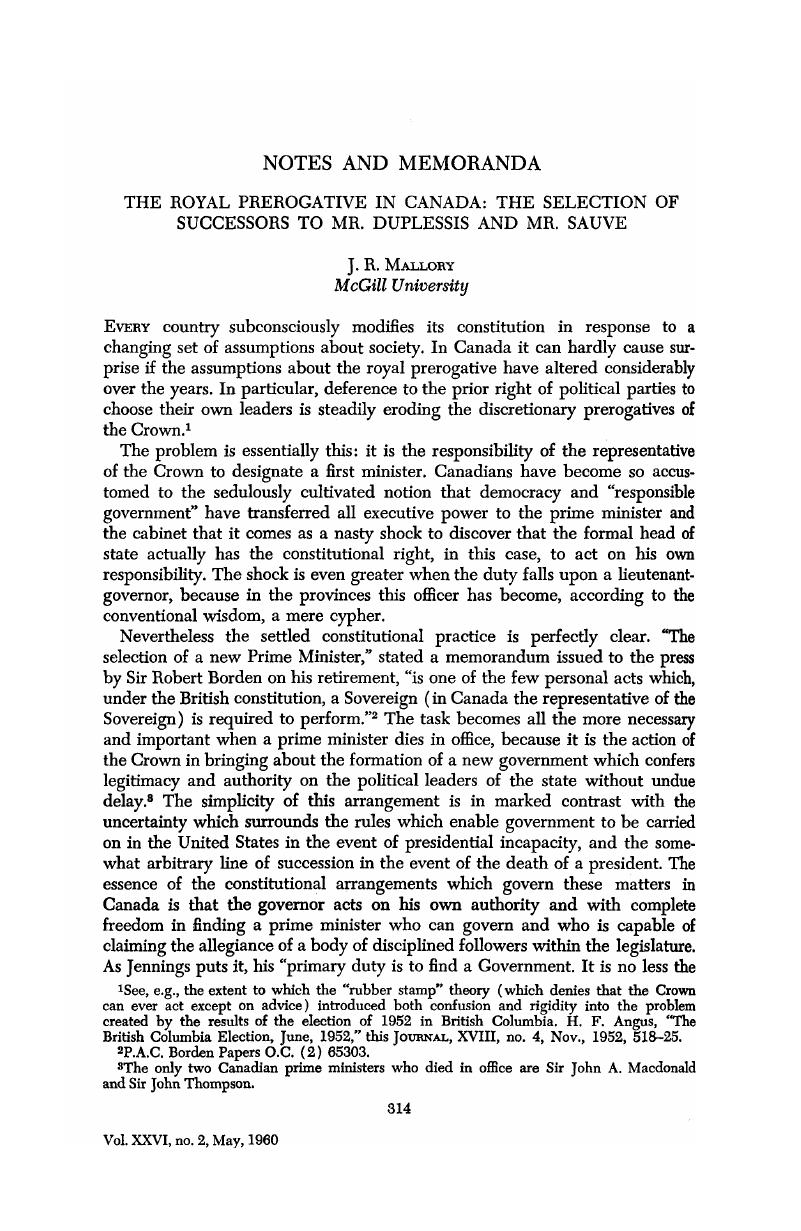Article contents
The Royal Prerogative in Canada: The Selection of Successors to Mr. Duplessis and Mr. Sauvé
Published online by Cambridge University Press: 07 November 2014
Abstract

- Type
- Notes and Memoranda
- Information
- Canadian Journal of Economics and Political Science/Revue canadienne de economiques et science politique , Volume 26 , Issue 2 , May 1960 , pp. 314 - 319
- Copyright
- Copyright © Canadian Political Science Association 1960
References
1 See, e.g., the extent to which the “rubber stamp” theory (which denies that the Crown can ever act except on advice) introduced both confusion and rigidity into the problem created by the results of the election of 1952 in British Columbia. Angus, H. F., “The British Columbia Election, June, 1952,” this Journal, XVIII, no. 4, Nov., 1952, 518–25.Google Scholar
2 P.A.C. Borden Papers O.C. (2) 65303.
3 The only two Canadian prime ministers who died in office are Sir John A. Macdonald and Sir John Thompson.
4 Jennings, W. I., Cabinet Government (London, 1947), 40.Google Scholar
5 See discussion of “Prerogative Powers of the Head of State (the Queen or Governor General)” by McWhinney, Edward, Canadian Bar Review, XXXV, no. 3, Jan., 1957, 92–6Google Scholar; by J. R. Mallory, ibid., XXXV, no. 2, Feb., 1957, 242–4; by Eugene Forsey, ibid., XXXV, no. 3, March, 1957, 368–9; and by Edward McWhinney, ibid., XXXV, no. 3, March, 1957, 369–71.
6 Sir John Bourinot summed up the position in a letter to N. O. Coté on March 20, 1895: “The Premier is the choice of the Crown or Governor-General and the Members of the Ministry, practically of the former. … The Governor-General, on the retirement or dissolution of a Cabinet, sends for a member of either House, and commissions him with the task of forming a new Cabinet. Should he accept the task, he is nominally the Prime Minister, but his position is conditional on his formation of a government. Should he fail, some one else would be commissioned. As a matter of fact, there is no appointment in the legal sense: the Governor-General authorizes a public man to assume the responsibility of forming a Cabinet. Only when the Premier takes a departmental office is there an appointment. The Premier is chosen under the conventions of the constitution. When he accepts the command of the Governor-General he is the Premier theoretically. From a strictly legal point of view, I should say the moment the new ministers are accepted, and are sworn in, there is a legal ministry, and a first minister.” Coté, N. O., Political Appointments: Parliament and the Judicial Bench in the Dominion of Canada, 1867–1895 (Ottawa, 1896), 31 n.Google Scholar
7 British Political Parties (London, 1955), 54.Google Scholar
8 There are interesting similarities with the procedure which was followed by the South African Nationalist party on the death of Prime Minister Johannes Strijdom on August 24, 1958. In this case the Governor General asked Mr. C. R. Swart, who had been Mr. Strijdom's Deputy Prime Minister, to head an acting administration in which all ministers retained the same portfolios as before. Meanwhile the parliamentary caucus of the party was summoned. The caucus chose Dr. H. F. Verwoerd as leader, after which the Governor General commissioned Dr. Verwoerd to form a government.
- 3
- Cited by


